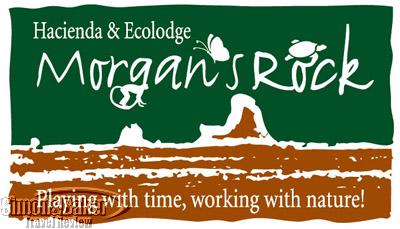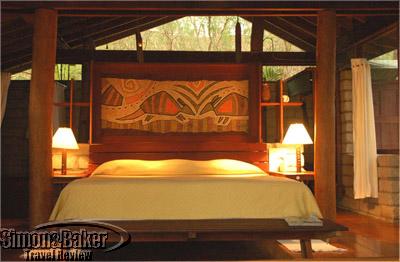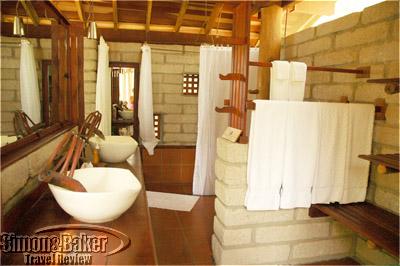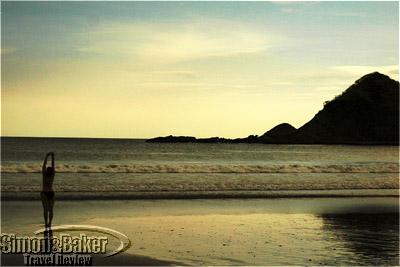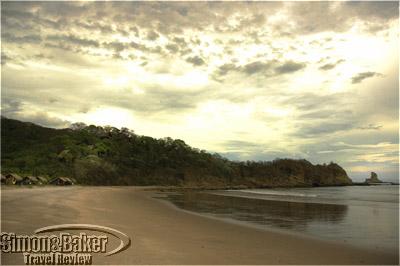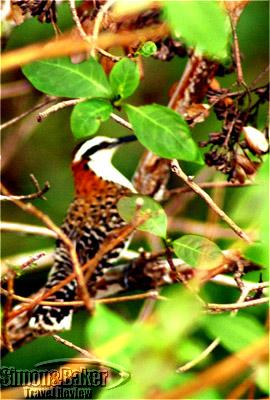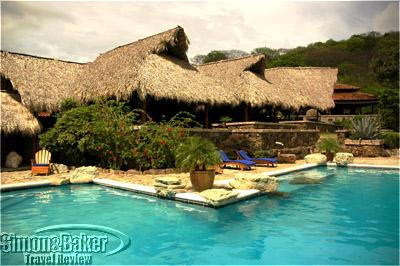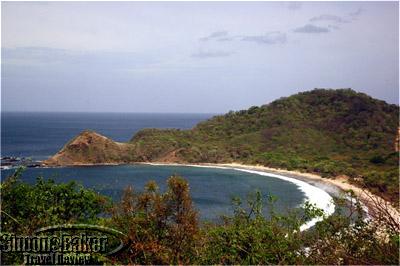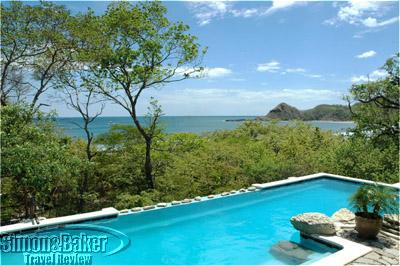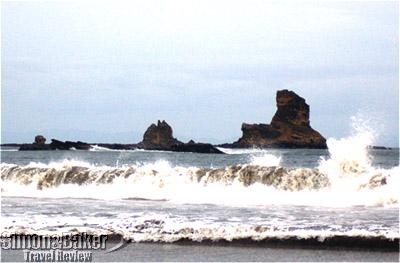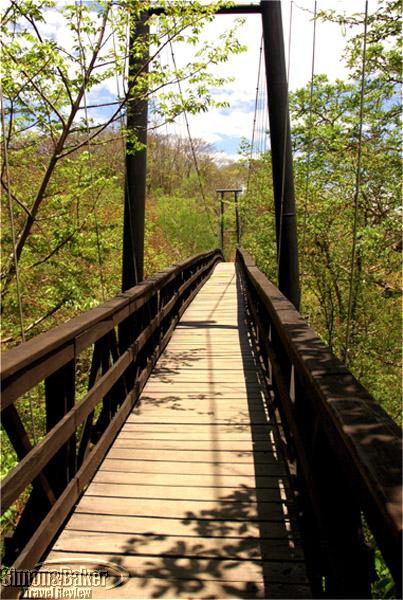
It was early afternoon by the time I arrived at Morgan’s Rock. The only thing warmer than the tropical sun overhead was the welcome from the staff. Standing in the open reception area, I got a first glance at the cerulean blue expanse of the infinity-edge pool just a few steps away. Beyond it, a clutter of lush vegetation stretched down to the edge of a crescent-shaped beach. The air was fragrant with tropical scents, and echoing with the dull beat of the surf. Although the cool, palm-thatched dining room beckoned, and lunch had been immediately suggested, it could wait. For now, I wanted to discover more of this seductive place. With scampering lizards leading the way, a staff member escorted me up terraced stairs to the awesome 360-foot long suspension bridge that straddled the steep, densely forested gorge separating the bungalows from the main hacienda. The bridge treated me to a canopy walk with a close-up look at birds and butterflies, and a sweeping view of the beach.
The fifteen guest bungalows were scattered in old-growth tropical forest, a few hundred feet above the surf, on a rolling hillside that curved to form the south end of the bay. Like everything else at Morgan’s Rock, the bungalows integrated unobtrusively into the surrounding nature. Only their thick locus wood doors set in high walls of white stone and their peaked thatched roofs were visible from the path. The fronts of the bungalows, built on stilts, reached out through the trees toward the ocean.
Equally as compelling as the view was the serene refinement of my bungalow’s interior. Constructed exclusively of local rare woods (all coming from certified, responsibly managed logging and recycling sources), the interior showcased the creativity of the architect, English expatriate Matthew Falkiner, and the skill of the local craftspeople in creating an environment of calm, understated beauty reminiscent of oriental retreats.
Connectivity There was no cell phone reception anywhere on Morgan’s Rock. Telephone and dial-up internet access were available from an outlet near the reception area. A computer was available for guests who may have felt compelled to check their e-mail. It didn’t appear to be much in demand any time during my stay.
Handicapped Access No. Getting around Morgan’s Rock required extensive walking up and down terraced paths and stairs.
Length Of Stay Three nights
Location Managua, with the only modern international airport in Nicaragua, was a three-hour drive northwest of Morgan’s Rock. The colonial city of Granada, one of the main tourist attractions in the country, was two hours away.
Road transportation to and from Managua or Granada, or any other destination, was easily arranged through the resort. Within Morgan’s Rock, the only way to get around was on foot. Excursions outside of the resort were arranged to include round trip transportation. A local airline, NatureAir, operated from Granada’s grass landing strip airport to other cities in Nicaragua and south to Costa Rica.
On-Site Manager Gladis Zapata.
Owners Morgan’s Rock Hacienda and Ecolodge was owned and operated by a French family, Clément and Claire Ponçon, and their sons Eric and Arnold. Ponçon, an agronomist, originally came to Nicaragua in 1974 on assignment from the French Government foreign assistance program. The family settled in Managua, and over time acquired several agricultural properties, focusing mainly on coffee and tree farming, including the working hacienda in Playa Octal that is now the site of Morgan’s Rock. The Ponçons credit the Lapa Rios Ecolodge, in Costa Rica, and its owners John and Karen Lewis, recognized pioneers in conservation and low-impact, sustainable development, for providing the inspiration behind Morgan’s Rock.
Size The property was nestled on approximately 25 acres, at the heart of a 4,500-acre full-scale conservation, tree-farming and reforestation project. Its 15 guest bungalows were scattered around a steep hillside, a five to ten-minute walk, over the suspension bridge and through the forest, from the main hacienda that housed the reception, restaurant, bar and pool.
The ecolodge employed a staff of 45, all Nicaraguan nationals, almost exclusively from the local community.
Year Open-Renovated Morgan’s Rock opened in October 2005
Room My bungalow, number 12, was the furthest from the lodge, a ten-minute walk to the very edge of the property. I was rewarded for the extra steps with a breathtaking circular view of the bay, the open ocean and Morgan’s Rock itself, the jagged promontory emerging from the Pacific surf that gave its name to the resort. Number 12, or Caoba (each bungalow was named after a local tree; mine was Mahogany) was a generously scaled 650-square-foot bedroom, sitting room and bathroom suite. With its wide private entrance patio and deck that ran the length of the room and extended a few feet beyond it into the trees toward the sea, it felt like a private world. The two walls facing the hill were of white rock. The two other sides were entirely screened-in, for a floor-to-ceiling view of the forest and the ocean.
The suite was on two levels, with the sleeping area on the main level. Set against a partition that separated it from the bathroom, the king size bed was flanked by two bedside tables. A large, bright bark painting of local animals was set in the partition above the headboard. A superbly crafted teak chest graced the far wall. There was ample indirect lighting around the room, and two overhead fans to ensure comfortable air circulation. All were powered by passive electricity from solar panels unobtrusively located just outside of the bungalow. The sitting area was two steps below the main part of the room, facing the sea. It included a king size sofa bed upholstered in cinnamon-colored canvas, a writing desk and chair. Large screened-in French doors opened onto the deck with its swinging queen size daybed comfortably padded in dark green canvas, hanging on thick ropes from its own thatched roof. It quickly became my favorite place to read, or to enjoy the pounding of the surf 300 feet below. I was occasionally visited there by a howler monkey that settled high in the trees to share the sunset with me.
The food was wholesome and delicious. It was served on attractive contemporary French china, making each meal a pleasure for the eye as well as the palate. The menu consisted of simple, well prepared dishes that were an interesting fusion of local Latin American dishes and French specialties. As only freshly harvested ingredients were used, the daily specials were influenced by what was available from the farm and the ocean. I especially enjoyed a spicy Bouillabaisse-like fish stew, based on the local catch of the day, flavored with lime and cilantro, with a bite of chili. The Kahlua Flan, a generous wedge of velvety custard with a subtle coffee flavor, served on rich vanilla cream, instantly became my favorite dessert.
Facilities In addition to the restaurant and bar overlooking the swimming pool, the main hacienda offered a number of inviting lounging areas. There was also a small library corner, with an eclectic, ever-changing collection, depending on what books guests either adopted or donated during their stay. A yoga deck and massage room were located high on a hill, a steep five-minute walk behind the hacienda.
Fitness Center The yoga deck and massage room were located high in the trees, a steep five minute walk behind the main lodge, facing the beach for a panoramic view of the bay and the soothing impression of nesting in the canopy. Massages were by appointments only, three days per week at the time of my visit. The only disappointment of my entire stay was self-inflicted. I waited too long to schedule a massage, and was unable to obtain an appointment on short notice. Next time, I will book it as I check in.
Pool The spectacular, over 60-foot long and up to 8-foot deep L-shaped swimming pool, contained several pre-existing boulders embedded in its sides. Some of them were just right to sit on, and linger in the water while watching the occasional bird stop by for a drink. The pool used no chlorine. It was kept clean with natural salts. A dozen large lounge chairs with thickly padded bright blue canvas cushions surrounded the pool area, half of them sheltered from the sun by a thatched roof. A few feet away, a walk-in closet held stacks of towels.
The beach of Morgan’s Rock was a protected nesting ground for giant leatherback sea turtles. They came to the beach to lay their eggs from August through January. Hotel staff guarded the nests to protect them from poachers. Guests who visited during the winter months could request to be awaken during the night, to watch the hatchling turtles flap their way down to the sea.
A variety of nature tours within the reserve were led by the knowledgeable and enthusiastic resident guide, Juan Guido, for groups of up to four or six people. Other excursions could be arranged through the resort, ranging from horseback riding to sea kayaking and fishing. For those wishing to explore further afield, day trips were available to Granada, Lake Nicaragua, the Mombacho Volcano Nature Reserve and the Massaya Volcano National Park.
Date Of Review May 2006
ReviewersArticle and photographs by Josette King
Service Excellent
Would You Stay There Again? Yes
Contact Information
- Playa Ocotal,
- Southern Nicaragua
- + (506) 232-6449
- + (506) 232-6297
